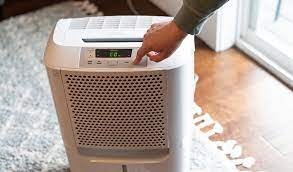A home or room with high humidity can feel stuffy, musty and cramped. Additionally, excessive humidity levels can result in dampness and unwanted moisture, which can breed microorganisms like bacteria and mould. As a result, it could be harmful to your family’s health.
Fortunately, you can reduce humidity levels in your home in many ways using a dehumidifier. It controls the moisture quantity in the air within a particular area.
So how do you lower the level of humidity using a dehumidifier? Let’s find out.
Table of Contents
Choosing the Ideal Dehumidifier
How big the space you want to dehumidify will determine what size of dehumidifier you should purchase. The main room where the dehumidifier will be used should have a square metre measurement. Compare that to the dehumidifier’s size.
Dehumidifiers are divided into categories based on room size and the amount of moisture in the space. The amount of water taken from the environment daily is measured in litres. Your room will then have the right level of humidity as a result.
Drying out a space more rapidly is possible by using a bigger dehumidifier. You won’t need to empty the reservoir as often, too. Larger units, on the other hand, cost more and consume more power, increasing your overall expenses.
Putting Your Dehumidifier at the Right Spot
If your dehumidifier has an air discharge installed on top, you can place it against a wall. Otherwise, make sure you leave enough space around it. Your unit will operate more effectively if there is better air circulation.
Also, keep the dehumidifier away from sources of dust and filth, such as machinery used for woodworking. Bathrooms, laundry rooms and basements are the spaces that often retain the most moisture. Hence these are the locations where you should install your unit.
Another thing to consider is that using a dehumidifier in a single room with closed doors and windows will maximise its effectiveness. Put your dehumidifier as close to the room’s centre if possible. It’ll also optimise its efficiency.
There are few portable types, but most dehumidifiers are wall-mounted.
Adjust the Dehumidifier Settings
Run the dehumidifier until the relative humidity level is optimal. It’s essential to run your humidifier in a few cycles. The most productive usage comes from the first time you use the unit. Over the first few hours, you will eliminate most excess water in the air.
After the first cycle, you will only need to maintain a suitable amount of humidity rather than drastically reduce it.
Keep the Room’s Doors and Windows Closed
Your dehumidifier will work harder if the room has a wider space. If you close the room with the unit inside, it’ll only operate to remove moisture from such a room. When dehumidifying the bathroom, pay attention to possible sources of extra water.
Keep the toilet lid closed to prevent your dehumidifier from taking water from it.
Regularly Empty the Water Reservoir Tray
Depending on the humidity of the space in which it is running, your dehumidifier can generate a significant amount of water. You must routinely empty the water reservoir tray if you do not use a hose to drain the water.
The unit should automatically shut off when the tray is filled with water to avoid overflow.
- Before emptying the water, unplug your unit.
- To get the approximate frequency of emptying the tray, check the manufacturer’s instructions of your dehumidifier.
- If the air is humid, check your reservoir tray every couple of hours.
Consider the Features You Need
Dehumidifiers have numerous functions and settings today, and the more costly it is, the more selections it has. Among the various features are:
Automatic defrost
Frost may readily accumulate on a dehumidifier’s coils if used excessively. This can affect the dehumidifier’s parts. Also, the unit’s fan will continue to operate as long as there is an automatic defrost setting.
Adjustable humidistat
With this function, you can manage the humidity in the space. Get your optimal relative humidity level by setting the humidistat. The unit will turn off automatically when it reaches such a point.
Automatic turn off
When the humidity level is reached, or the water reservoir is full, most dehumidifiers will shut off automatically.
Built-in hygrometer
The dehumidifier can be regulated using the built-in hygrometer. It is to maximise water extraction by measuring the relative humidity in the space.
Using a Hygrometer, Assess Your Level of Humidity
There are a few common warning signs of high indoor relative humidity. It’s also indicated by moisture buildup or condensation on room ceilings and walls.
To check humidity levels in your home, you need a hygrometer, a device that gauges the air’s humidity level. About 45 to 50 percent relative humidity (RH) is considered optimum. Below 30% RH can contribute to structural damage to homes, such as cracked ceilings, split wood flooring and other problems.
Moreover, going beyond this level can trigger mould buildup.
Allow 10 Minutes Before Restarting
Ensure the unit is off for 10 minutes before restarting to prevent short cycling. Doing so can extend your dehumidifier’s lifespan. Dehumidifiers typically last between five to ten years. Hence, taking care of your unit to maximise performance is crucial.
Key Takeaway
Humidity is a common problem in homes, especially during the summer months. A dehumidifier can be a great way to combat high humidity levels and make your home more comfortable. If you’re considering purchasing a dehumidifier, this guide will help you choose the right one for your needs.

